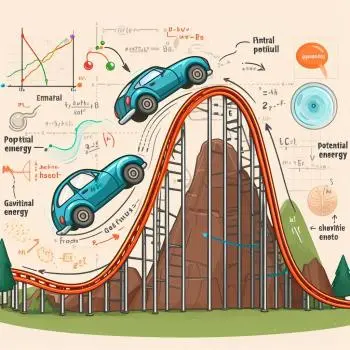
Gravitational potential energy, also known as gravitational energy, is a particular type of potential energy that underlies many of the phenomena we experience in our daily lives, from throwing a ball in the air to understanding how hydroelectric power plants work.
In this article, we'll define gravitational potential energy in detail, use the formula for calculating it, and provide two completed exercises and application examples to help you better understand this type of energy.
Definition of gravitational potential energy
Gravitational potential energy is a form of energy that an object possesses due to its position in a gravitational field, such as that of the Earth.
When an object is at a certain height above a reference point, such as the ground, it accumulates gravitational potential energy. This energy is ready to be converted into kinetic energy, that is, the energy of motion, when the object falls.
Formula for gravitational energy on Earth
 The formula for calculating gravitational potential energy on the Earth's surface is as follows:
The formula for calculating gravitational potential energy on the Earth's surface is as follows:
\[ E_p = m⋅g⋅h \]
Where:
-
\(E_p \) is the gravitational potential energy (in joules, J).
-
\(m\) is the mass of the object (in kilograms, kg).
-
\(g\) is the acceleration due to gravity at the location where the object is located (in meters per second squared, m/s²).
-
\(h\) is the height of the object above the reference point (in meters, m).
Acceleration of gravity
The value of the acceleration due to gravity (g) at the Earth's surface can vary slightly depending on geographic location, altitude, and other local factors, but an average value of approximately 9.81 meters per second squared (m/s²) is commonly accepted.
Gravitational energy in non-uniform gravitational fields
In non-uniform gravitational fields, such as those created by massive bodies in space or at great distances from the Earth's surface, the acceleration of gravity g is not constant and varies with the distance from the center of the massive body.
In these cases, the formula for gravitational potential energy is calculated using Newton's law of universal gravitation.
The gravitational potential energy in a non-uniform gravitational field is described by the following formula:
\[ E_p = - \frac{G \cdot M \cdot m}{r} \]
Where:
-
\( E_p \) is the gravitational potential energy (in joules, J).
-
\( G \) is the universal gravitational constant (\( 6.674 \times 10^{-11} \, \text{Nm}^2/\text{kg}^2 \)).
-
\( M \) is the mass of the body that generates the gravitational field (in kilograms, kg).
-
\( m \) is the mass of the object that is in the gravitational field (in kilograms, kg).
-
\( r \) is the distance from the center of mass MMM to the object mmm (in meters, m).
Characteristics of gravitational energy
Gravitational energy is the potential energy associated with an object due to its position in a gravitational field. Some of its key characteristics are as follows:
- Height Dependence : Gravitational energy directly depends on an object's height relative to a reference point (such as sea level or the Earth's center). The greater the height, the greater the gravitational energy.
- Gravitational force : This energy is related to the gravitational force that attracts objects toward the center of the Earth (or any other massive celestial body). Gravitational energy is greater when an object is farther from the source of gravity.
- Conservation of Energy : Gravitational energy is conserved in an isolated system. This means that, in the absence of other external forces such as friction, gravitational energy can be transformed into other forms of energy, such as kinetic energy, but the total amount of energy in the system remains constant.
- Transformation into kinetic energy : When an object falls due to gravity, its gravitational energy is converted into kinetic energy. This is an example of energy conversion in a conservative system.
- Gravitational potential : This is a form of potential energy, and its value depends on the object's location in the gravitational field. As an object moves further away from Earth, its gravitational energy decreases, reflecting a weakened gravitational pull.
- Gravitational energy and orbits : In the case of celestial bodies such as planets, moons, or artificial satellites, gravitational energy is fundamental to describing orbital motion. The gravitational energy of an orbiting satellite is related to the object's distance from the center of the planet or star orbiting it.
Relationship between both formulas
The formula for gravitational potential energy is a direct consequence of Isaac Newton's law of universal gravitation. The relationship between gravitational potential energy and the force of gravity is established through the work done by the force of gravity when moving an object in a gravitational field.
When an object moves vertically in a gravitational field (for example, when it falls from a certain height), the work done by the force of gravity is converted into gravitational potential energy.
The relationship between these two formulas is evident when we consider how the work done in moving an object vertically translates into a change in its gravitational potential energy.
Everyday examples
To better understand this concept of energy, we present some real examples:
-
A ball in the air : Imagine you have a ball in your hand and raise it to a certain height above the ground. In this case, the ball's gravitational potential energy increases as you raise it. When you release it, the potential energy is converted into kinetic energy, and the ball falls to the ground.
-
Hydroelectric power plant : Hydroelectric power plants harness the gravitational potential energy of water stored in an elevated reservoir. When a floodgate is opened, water falls from a great height, turning turbines and generating electricity in the process.
-
 Skydiving or paragliding : When a skydiver ascends in an airplane, they accumulate gravitational potential energy. During the jump, this potential energy is converted into kinetic energy as they undergo what in kinematics is known as uniformly accelerated linear motion. As the skydiver descends, their speed increases until the parachute opens, slowing their fall.
Skydiving or paragliding : When a skydiver ascends in an airplane, they accumulate gravitational potential energy. During the jump, this potential energy is converted into kinetic energy as they undergo what in kinematics is known as uniformly accelerated linear motion. As the skydiver descends, their speed increases until the parachute opens, slowing their fall. -
Projectile launch : In projectile launch situations, such as a space rocket, gravitational potential energy is converted into kinetic energy as the object ascends. As the projectile ascends, its potential energy increases, and as it descends, this potential energy is converted into kinetic energy due to the law of conservation of energy. A rocket launched into space, for example, uses this energy conversion to escape Earth's gravity.
-
Hot Air Balloon Ascent : A hot air balloon uses gravitational potential energy to ascend. When the air inside the balloon warms and becomes less dense, the balloon rises, accumulating potential energy. In this case, the thermal energy of the hot air is converted into gravitational potential energy as the balloon rises.
-
Mountain climbing : When climbing a mountain, climbers elevate their bodies to a greater height above sea level. This gives them greater gravitational potential energy, which accumulates as they climb. This potential energy is released as they descend, such as when walking down a hill, and some of that energy can be transformed into kinetic energy.
-
Waterfall : In a natural waterfall, water falling from a great height converts its gravitational potential energy into kinetic energy as it descends. This conversion allows the water to gain speed, ultimately impacting the river or lake floor and creating the force that can be used to generate electricity in a hydroelectric plant.
-
Elevator ascent : In a multi-story building, an elevator raised to a higher floor increases its gravitational potential energy, as it is higher relative to the initial level. This energy is used to balance the gravitational force as it moves downward, or it can be harnessed by an energy regeneration system.
Solved exercises
Now let's look at some examples of solved exercises in which the formula shown above is applied:
Exercise 1
Calculate the gravitational potential energy of a rock with a mass of 5 kg that is 10 meters above the ground. Use an acceleration due to gravity of 9.81 m/s².
Solution
E p = m⋅g⋅h
E p = 5kg ⋅ 9.81m/s² ⋅ 10m = 490.5J
The gravitational potential energy of the rock is 490.5 joules.
Exercise 2
Suppose a person lifts a 20-kg box 2 meters above the ground. Calculate the box's gravitational potential energy.
Solution
E p = m⋅g⋅h
E p = 20kg ⋅ 9.81m/s² ⋅ 2m = 392.4J
The gravitational potential energy of the box is 392.4 joules.